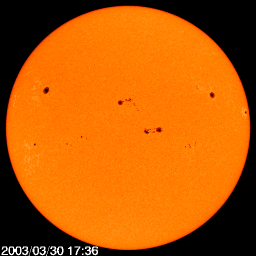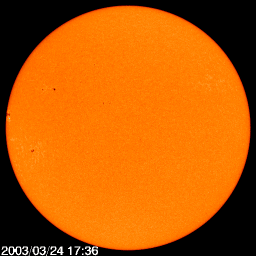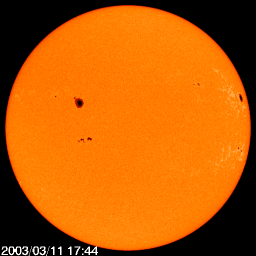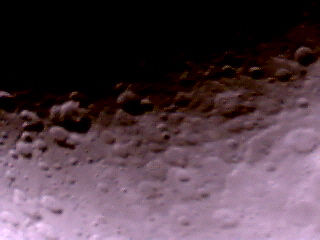
Tonight I was outside, watching the sky darken. I took out the scope for a free run across the sky. I first stopped at Jupiter. The SEB and NEB were easily visible. The Great Red Spot was not seen. Three moons were off to the left of the planet, one to the right. Just above Jupiter I could fit about half of M44 in the 25mm eyepiece along with Jupiter.
Next I moved to M81 and M82, in Ursa Major. Both easily visible in the 25mm and 20mm eyepieces. Just watching these two galaxies, frozen in time... as they travel across our sky. I watched these two for quite awhile, before moving on to Leo.
M65 and M66 were next. Spotted them both easily. Like M81 and M82 these galaxies are close enough to fit into the same field of view. After that I just watched the constellations rise, turned on some music... and wished that someone I hold special was here.
"And it feels, and it feels like... Heavens so far away."
March 30, 2003
Objetcs observed: The Sun.
Right now the Sun is going through a very spotty phase. This is the most spotty I have seen the sun since I purchased the Solar Filter. The total number of spots is huge. There are many large spots as well as plenty of smaller ones.

"SOHO (ESA & NASA) MDI"
The spot to the right in the image on the limb is 320. The large sopt to the left is 325. 325 was exceptionally interesting as it seemed to be made up of numerous spots instead of one large one. The large groups in the center were also very interesting. The amount of spots there is amazing. The Sun is going through a very spotty phase right now. If you have a Solar Filter I would recommend taking a look.
March 24, 2003
Objects observed: The Sun.
Not much happening on the face of the Sun due to large coronal holes on the Sun. However, there were some small sunspots visible, as well as a fairly large one on the limb.

"SOHO (ESA & NASA) MDI"
The spot located on the Sun's limb is located on the left in the image. When looking through the scope that spot is on the bottom of the Sun. Since my Telescope is a Reflector it flips the image around. Also, the spot down and to the right of the one on the limb was interesting as it is actually two spots very close to each other.
March 21, 2003
Objects observed: Jupiter, Saturn, M1, M44, M65, M66, M81, M82, M105.
Viewed a new object tonight, M105. I started off the session looking at Saturn and Jupiter to get my eyes dark adapted. Saturn was showing nice detail along with the Cassini Division and a equatorial band. I really didn't take the time to look at its moons so I am unsure of what their positions were. After leaving Saturn I moved over to Jupiter. The NEB and SEB were clearly visible. The Great Red Spot was not visible. I couldn't detect any detail within the bands either.
Moving just above Jupiter brought M44, the large beehive cluster. Many stars are visible in this cluster and it took up the whole field of view. This cluster looks to have more stars than M45, The Pleiades.
Next I move to M81 and M82. I'm surprised at how easy I can find these two galaxies now. There is a star in the sky that I can align to and the galaxies are really close to it. So I just move the telescope alittle and voila M81 and M82 appear in the Field of View. These galaxies are bright and extremely easy to see. These are perhaps the best pairing of galaxies in the sky.
After M81 and M82 comes M65 and M66. Located between the stars Chertan and 78 Iota Leonis. M65 and M66 both appear in the same field of view. M66 has a star very close to it making it easy to spot and identify the two galaxies. Once again I didn't see NGC 3628, but I wasn't looking too hard for it.
After I viewed those two galaxies I decided to move to M105. I found and confirmed M105. There was a bright triangle of stars to the bottom right of M105 and two stars that looked like a double to the bottom left. Using these stars I confirmed that I was indeed seeing M105. Moving up I spotted another galaxy. Most likely M96 but I will wait on the confirmation untill I see M95 as they are close together. I searched for M95 but am not sure that I saw it. Overall either M96 or M95 are proving to be a tough object. Most likely M95 as it is magnitude 9.7 and M96 is magnitude 9.2.
March 16, 2003
Objects observed: Moon, Jupiter, Saturn, M42, M44, M45.
It was cloudy this morning, cleared up this afternoon when I viewed the Sun and then began to cloud again. However, something happened and the sky cleared... totaly unexpected. I didn't take the scope out, instead I took a quick walk around the sky with the 10x50 binoculars. Starting off with the Moon, in its Waxing Gibbous phase. Approximately 96% of the Moons face was visible. Many features were visible. And I returned to the Moon about two more times the time I was out.
Next up was Jupiter shining brightly. I think I saw one of Jupiter's moons through the binoculars... but it was really hard to tell as I cannot hold the binoculars steady enough. M44 the beehive was visible just above Jupiter as a large cluster of stars in the binoculars. I took a few more minutes to look at Jupiter and M44 before moving into Orion.
First stop in Orion was M42. M42 is a great object to look at in the Binoculars. It seems that there are a couple stars within this nebula when you view it. But the greatest part of it is the large amount stars that surround this nebula. It very nice to "zoom out" and get a far off view of the objects I usually view through the Telescope. I didn't only come to Orion just to view M42. I also took a look at Betelgeuse. Betelgeuse was extremly red in color and quite bright, another great target for the binoculars.
A quick hop over into Taurus brings us to Saturn. Although the rings are not visible in the binoculars it is still a nice view. It appears as a very orange color. It also dosn't seem to be circular in shape, somewhat elongated. Now, only a quick hop over brings in the last object for the night. M45, The Pleiades.
M45 as well as M44 make great binocular objects. M45 with its dipper shape is easily visible to the naked eye. People often get confused with it and assume it as the little dipper. This a great object, so many stars visible. Although the binoculars do not show it, I know the Pleiades is covered in nebula. It is reflection so the nebula appears to be blue in color. After setting the binoculars down I take a look at the sky as a whole. Although the Moon was out and nearly full, plenty of stars were visible. I decided it was time to go in. A good night with the binoculars.
March 16, 2003
Objects observed: The Sun.
Got to view and image the Sun today. Sunspot 306 is still visible. Now there is sunspot 314 that is showing lots of detail! Both of these spots are towards the top of the sun in the telescope. I didn't take my images today by using the webcam. Today I used eyepiece projection and held a camera to the eyepiece. Both of these spots have nice detail and structure in the umbra and penumbra.

Sunspot 306 is to the left in the image. 314 is located to the right. The small spot above them both is 311. The sun has been recently showing some great detail and if you have a filter, I'd recommend you take a look.
March 13, 2003
Objects observed: The Sun.
Since I didn't get to look at the Sun yesterday, I had to look at it today. The Sun was behind some clouds and a bit of trees but was visible. After aligning the shadow of the scope so that it takes a circle in shape, I took a look into the eyepiece.

"SOHO (ESA & NASA) MDI"
Sunspot 306 is still very easily visible, however 296 has left the earth facing side of the sun. I couldn't see much more on the sun other than 306 since it was behind the trees and clouds.
March 12, 2003
Objects observed: Moon, Saturn, Jupiter, M44.
Took the scope for a quick observation session. Since the Moon was out and blocking most of the deep sky stuff I decided to mostly just limit this session to objects within our Solar System. Where did I point the telescope to first? The Moon.
I took a quick walk along the terminator, visited a few craters. But tonight it wasn't too long untill I lost my intrest in the Moon. I probably spent about ten minutes watching it... the shadows climbing along the crater walls. I decided to move on, to a new target.
Next up was Saturn... the ringed wonder. Stranded out in space it lays looking frozen time. How long has it taken the light from Saturn to reach my eyes? How long ago was Saturn actually looking like this? Saturn and its moon Titan were easily visible. I watched it for only a few more minutes and then decided to move on.
Jupiter the King of the planets, decided not to show that much detail. I could only detect the SEB and NEB along with the planet darkening towards its poles. The Great Red Spot is not transitting and I can't pick out any detail in the bands, maybe I'm just too tired right now. I put in the 20mm and start scanning the area around Jupiter.
I ran into M44, a large open cluster of stars visible even with the moon so bright. I could point my scope at the Moon by the telescopes shadow, just like you do the Sun. M44 was large and easily visible, as not too many other stars were visible around this cluster. I thought about looking at some Double Stars, but decided not too. Its time to pack up and go in.
March 11, 2003
Objects observed: The Sun.
Got the scope out this afternoon to have a look at the sun as I have heard there is a bit of activity going on. There was. A huge sunspot number 306 was towards the bottom of the sun in the telescope. I could put in the 6.3mm and get great views of structure and detail on this spot. The dark umbra in the center had a very crinckley edges. Surrounding the Umbra was the lighter Penumbra, also showing much structure and detail.

"SOHO (ESA & NASA) MDI"
There was also a interesting spot towards the top of the sun in the scope (to the right in the image). I will have to check the sun again tomorrow to see the progress of sunspot 306 on its journey across the suns face.
March 09, 2003
Objects observed: Moon, Saturn, Jupiter.
Tonight was dedicated to imaging the Moon and planets. First up was the moon, showing great detail along the terminator.


After making various notes on the moon I pointed the scope to Saturn to take some images. I have not processed the images of Saturn yet so I'm not sure how good they will turn out.
Next up was Jupiter as I wanted a image of it while the Great Red Spot is transitting. Here is the result:

The red square in the image at right helps Identify the GRS in the image at left.
March 3, 2003
Objects observed: M51, M65, M66, M81, M82, M97, M108, NGC 5195, Jupiter.
This was a early morning obervation session starting at around 12:30 AM. Set up the scope outside. It was a little hazey out but hey, I could see plenty of stars! Ursa Major was high up, and I could not wait untill I set the scope upon M81 and M82. So as you can guess the first targets for the night was this galactic duo. Both were easily visible, although fainter than usual. I guess you can blame that on the light haze. I used the 10mm on M81 and M82. I couldn't see any of the spiral structure in M81 with the 10mm even with wide aversion. So I decided to move over to M82. M82 was wondeful, its irregularity was obvious... the Cigar is a perfect name for this galaxy. The core features were not as prominent like the last time I viewed this one... again most likely down to the conditions of the night. After a quick view of them both in the 25mm I decide to move on to the Owl Nebula, M97.
The Owl Nebula was much, much fainter than usual, but was fairly prominent in the 25mm. It appeared as a faint circular patch of light. I decided not use any different magnifications as it was already fairly faint in the 25mm. Now all we must do is take a very short hop and we land on the M108. just above the bottom of an upside down "Y" of stars. I could get a sense of its shape, but mostly appeared as a faint elongated patch of light. Time to move on.
Now it is time to view one of the greatest galaxies the universe has to offer... M51! A quick hop from Alkaid brings us the amazing M51 and its companion NGC 5195. They were both easily visible in the 25mm eyepiece, but I wanted to try to get some structure. I put in the 10mm, refocus on a nearby star and then move back to M51. I could not see any structure, even under wide aversion. I might have better luck on a night that is more clear. However, not seeing the structure dosn't ruin the view. Just looking at how close these two galaxies are is amazing! But still the thoughts of that spiral arm of M51 reaching out and grabbing NGC 5195 will forever locked into my mind. And I will continue to try to see the structure in M51. But now we will make a huge hop across the sky into Leo.
The sky is getting a little more cloudy with the occasional large cloud floating by, however I still got my sights locked onto the M65 and M66. Another galactic duo! They were both easily visible although like everything else tonight, much fainter than usual. I looked all around them for NGC 3628 but couldn't see it. Will have to save 3628 for a clearer night. The clouds are still getting worse so I decided to have a quick visit with Jupiter before taking the scope in. Callisto was to the far right, while Io Europa and Ganymede were to the left. The Great Red Spot was not visible, however while I was looking for it I noticed a shadow on the planet! I went inside to confirm what I saw. Indeed there was a shadow transit, Io was casting its shadow upon Jupiter. It is 1:25 AM, so I decide it is time to come back inside. Over all a nice session, would have been better without the haze.
